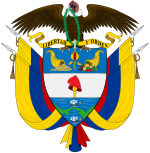
Back Groot-Colombia Afrikaans كولومبيا الكبرى Arabic كولومبيا الكبرى ARZ Gran Colombia AST Böyük Kolumbiya Azerbaijani بؤیوک کولومبیا جومهوریتی AZB Бөйөк Колумбия Bashkir Вялікая Калумбія Byelorussian Велика Колумбия Bulgarian গ্রান কলম্বিয়া Bengali/Bangla
Republic of Colombia República de Colombia | |||||||||||||||||||
|---|---|---|---|---|---|---|---|---|---|---|---|---|---|---|---|---|---|---|---|
| 1819–1831 | |||||||||||||||||||
Emblem
(1821–1831) | |||||||||||||||||||
| Motto: Unión (Spanish) | |||||||||||||||||||
| Anthem: Marcha Libertadora (Spanish) | |||||||||||||||||||
 Territory controlled by Gran Colombia (does not include Mosquito Coast) | |||||||||||||||||||
| Capital | Bogotá | ||||||||||||||||||
| Common languages | Spanish and Indigenous languages | ||||||||||||||||||
| Religion | Roman Catholicism (official) | ||||||||||||||||||
| Government | Federal presidential republic | ||||||||||||||||||
| Presidents | |||||||||||||||||||
• 1819–1830 | Simón Bolívar Estanislao Vergara y Sanz de Santamaría | ||||||||||||||||||
• 1830, 1831 | Domingo Caycedo | ||||||||||||||||||
• 1830, 1831 | Joaquín Mosquera | ||||||||||||||||||
• 1830–1831 | Rafael Urdaneta | ||||||||||||||||||
| Vice Presidents | |||||||||||||||||||
• 1819–1820 | Francisco Antonio Zea | ||||||||||||||||||
• 1820–1821 | Juan Germán Roscio | ||||||||||||||||||
• 1821 | Antonio Nariño y Álvarez | ||||||||||||||||||
• 1821 | José María del Castillo | ||||||||||||||||||
• 1821–1827 | Francisco de Paula Santander | ||||||||||||||||||
• 1830–1831 | Domingo Caycedo | ||||||||||||||||||
| Legislature | Congress | ||||||||||||||||||
• Upper Chamber | Senate | ||||||||||||||||||
• Lower Chamber | Chamber of Representatives | ||||||||||||||||||
| History | |||||||||||||||||||
| December 17,[1] 1819 | |||||||||||||||||||
| August 30, 1821 | |||||||||||||||||||
| 1828–1829 | |||||||||||||||||||
| November 19, 1831 | |||||||||||||||||||
| Area | |||||||||||||||||||
• Total | 3,064,800[2] km2 (1,183,300 sq mi) | ||||||||||||||||||
| Population | |||||||||||||||||||
• 1825 | 2,583,799[3] | ||||||||||||||||||
• Density | 0.84/km2 (2.2/sq mi) | ||||||||||||||||||
| Currency | Piastra | ||||||||||||||||||
| |||||||||||||||||||
| History of Colombia | ||||||||||||||||||||
|---|---|---|---|---|---|---|---|---|---|---|---|---|---|---|---|---|---|---|---|---|
 | ||||||||||||||||||||
| Timeline | ||||||||||||||||||||
|
||||||||||||||||||||
|
| ||||||||||||||||||||
Gran Colombia (Spanish pronunciation: [ˈɡɾaŋ koˈlombja] , "Great Colombia"), or Greater Colombia, officially the Republic of Colombia (Spanish: República de Colombia), was a state that encompassed much of northern South America and part of southern North America (aka southern Central America) from 1819 to 1831. It included present-day Colombia, mainland Ecuador (i.e. excluding the Galápagos Islands), Panama, and Venezuela, along with parts of northern Peru, northwestern Brazil, and claimed the Essequibo region. The terms Gran Colombia and Greater Colombia are used historiographically to distinguish it from the current Republic of Colombia,[4] which is also the official name of the former state.
However, international recognition of the legitimacy of the Gran Colombian state ran afoul of European opposition to the independence of states in the Americas. Austria, France, and Russia only recognized independence in the Americas if the new states accepted monarchs from European dynasties. In addition, Colombia and the international powers disagreed over the extension of the Colombian territory and its boundaries.[5]
Gran Colombia was proclaimed through the Fundamental Law of the Republic of Colombia, issued during the Congress of Angostura (1819), but did not come into being until the Congress of Cúcuta (1821) promulgated the Constitution of Cúcuta.
Gran Colombia was constituted as a unitary centralist state.[6] Its existence was marked by a struggle between those who supported a centralized government with a strong presidency and those who supported a decentralized, federal form of government. At the same time, another political division emerged between those who supported the Constitution of Cúcuta and two groups who sought to do away with the Constitution, either in favor of breaking up the country into smaller republics or maintaining the union but creating an even stronger presidency. The faction that favored constitutional rule coalesced around Vice-President Francisco de Paula Santander, while those who supported the creation of a stronger presidency were led by President Simón Bolívar. The two of them had been allies in the war against Spanish rule, but by 1825, their differences had become public and were an important part of the political instability from that year onward.
Gran Colombia was dissolved in 1831 due to the political differences that existed between supporters of federalism and centralism, as well as regional tensions among the peoples that made up the republic. It broke into the successor states of Colombia, Ecuador, and Venezuela; Panama was separated from Colombia in 1903. Since Gran Colombia's territory corresponded more or less to the original jurisdiction of the former Viceroyalty of New Granada, it also claimed the Caribbean coast of Nicaragua, the Mosquito Coast, as well as most of Esequiba.
- ^ Bethell, Leslie (1985). The Cambridge History of Latin America. Cambridge University Press. p. 141. ISBN 978-0-521-23224-1. Retrieved September 6, 2011.
- ^ https://biblioteca.dane.gov.co/media/libros/LD_70104_1957_EJ_2.PDF | Author: José Lanz | Page 36
- ^ http://commons.wikimedia.orgview_html.php?sq=Facebook&lang=en&q=Atlas_Geográfico_e_Histórico_de_la_República_de_Colombia_(1890) | Author: Imprenta A. Lahure
- ^ "Los nombres de Colombia". Alta Consejería Presidencial para el Bicentenario de la Independencia de Colombia. Archived from the original on September 18, 2016. Retrieved August 12, 2016.
- ^ "La búsqueda del reconocimiento internacional de la Gran Colombia". Biblioteca Nacional de Colombia. Archived from the original on October 11, 2016. Retrieved August 12, 2016.
- ^ Germán A. de la Reza (2014). "El intento de integración de Santo Domingo a la Gran Colombia (1821-1822)". Secuencia (93). Revista Secuencia: 65–82. Retrieved March 1, 2016.

